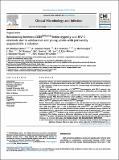Por favor, use este identificador para citar o enlazar a este item:
http://hdl.handle.net/10261/200101COMPARTIR / EXPORTAR:
 SHARE SHARE
 CORE
BASE CORE
BASE
|
|
| Visualizar otros formatos: MARC | Dublin Core | RDF | ORE | MODS | METS | DIDL | DATACITE | |

| Título: | Relationship between CCR5(WT/Δ32) heterozygosity and HIV-1 reservoir size in adolescents and young adults with perinatally acquired HIV-1 infection |
Autor: | Martínez Bonet, Marta; González-Serna, A.; Clemente, M. I.; Morón-López, S.; Díaz, Laura; Navarro Gómez, María Luisa; Puertas, M. C.; Leal, Manuel CSIC; Ruiz-Mateos, Ezequiel CSIC ORCID; Martínez-Picado, Javier; Muñoz-Fernández, María Ángeles CSIC ORCID | Palabras clave: | Adolescents CCR5(WT/Δ32) Human immunodeficiency virus-1 Reservoir size Young adults |
Fecha de publicación: | may-2017 | Editor: | Elsevier | Citación: | Clinical Microbiology and Infection 23(5): 318-324 (2017) | Resumen: | [Background] Several host factors contribute to human immunodeficiency virus (HIV) disease progression in the absence of combination antiretroviral therapy (cART). Among them, the CC-chemokine receptor 5 (CCR5) is known to be the main co-receptor used by HIV-1 to enter target cells during the early stages of an HIV-1 infection. [Objective] We evaluated the association of CCR5(WT/Δ32) heterozygosity with HIV-1 reservoir size, lymphocyte differentiation, activation and immunosenescence in adolescents and young adults with perinatally acquired HIV infection receiving cART. [Methods] CCR5 genotype was analysed in 242 patients with vertically transmitted HIV-1 infection from Paediatric Spanish AIDS Research Network Cohort (coRISpe). Proviral HIV-1 DNA was quantified by digital-droplet PCR, and T-cell phenotype was evaluated by flow cytometry in a subset of 24 patients (ten with CCR5(Δ32/WT) genotype and 14 with CCR5(WT/WT) genotype). [Results] Twenty-three patients were heterozygous for the Δ32 genotype but none was homozygous for the mutated CCR5 allele. We observed no difference in the HIV-1 reservoir size (455 and 578 copies of HIV-1 DNA per million CD4+ T cells in individuals with CCR5(WT/WT) and CCR5(Δ32/WT) genotypes, respectively; p 0.75) or in the immune activation markers between both genotype groups. However, we found that total HIV-1 DNA in CD4+ T cells correlated with the percentage of memory CD4+ T cells: a direct correlation in CCR5(WT/Δ32) patients but an inverse correlation in those with the CCR5(WT/WT) genotype. [Conclusions] This finding suggests a differential distribution of the viral reservoir compartment in CCR5(WT/Δ32) patients with perinatal HIV infection, which is a characteristic that may affect the design of strategies for reservoir elimination. |
Versión del editor: | http://dx.doi.org/10.1016/j.cmi.2016.12.020 | URI: | http://hdl.handle.net/10261/200101 | DOI: | 10.1016/j.cmi.2016.12.020 | Identificadores: | doi: 10.1016/j.cmi.2016.12.020 e-issn: 1469-0691 issn: 1198-743X |
| Aparece en las colecciones: | (IBIS) Artículos |
Ficheros en este ítem:
| Fichero | Descripción | Tamaño | Formato | |
|---|---|---|---|---|
| HIV-1_infectio.pdf | 423,92 kB | Adobe PDF |  Visualizar/Abrir |
CORE Recommender
SCOPUSTM
Citations
4
checked on 16-abr-2024
WEB OF SCIENCETM
Citations
3
checked on 27-feb-2024
Page view(s)
205
checked on 17-abr-2024
Download(s)
248
checked on 17-abr-2024
Google ScholarTM
Check
Altmetric
Altmetric
Este item está licenciado bajo una Licencia Creative Commons

